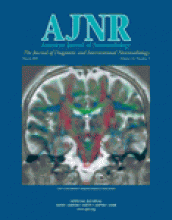Robert Hermans. Berlin-Heidelberg: Springer-Verlag; 2002. 192 pages, $99.
Imaging of the Larynx by Robert Hermans is an excellent treatment of a difficult subject. The book is part of a series on medical radiology organized by Professors Albert Baert and Klaus Sartor. It is an up-to-date, in-depth look at imaging of the larynx. Several chapters are directed at more peripheral interests applicable to the field.
Dr. Hermans served as editor for the volume and contributed many of the chapters himself, reflecting his ongoing interest and expertise in the larynx. Many other notable contributors have provided very readable and authoritative works to complete the effort. The final product is superb.
The overview is complete, the images are excellent, and the text is very smoothly written. The publication is brief enough to provide an excellent introduction to imaging of the larynx and complete enough to be of significant value to the most experienced head and neck radiologist.
The book begins with a brief overview of the clinical evaluation of the larynx. This section serves to put imaging into the appropriate perspective relating to patient management. The authors of this section, Delsupehe and Delaere, take us through the various types of endoscopy and phonoevaluations, but only after providing an overview of the anatomy of the larynx with excellent diagrammatic representations. After the clinical and anatomic introduction, Frank Pameijer and Hermans cover the same anatomy from the perspective of imaging, providing an excellent atlas of CT scans and MR images of the larynx. They also cover basic imaging techniques and strategies, including a discussion of technical considerations for multidetector CT.
The next few chapters are a combination of an overview of pathology and an in-depth exploration of some of the more important active issues in laryngeal imaging. Laryngeal malignancy is extensively covered. Such issues as preoperative planning and the use of imaging to predict prognosis are explained, and reviews of the literature are presented. Sections on postoperative and postradiation considerations offer very practical information regarding these difficult imaging areas.
Completing the publication are chapters on positron emission tomography of the head and neck by Patrick Flamen and a final chapter on recent advances in laryngeal imaging. These final sections provide an update on several new technologies and their application to the larynx, along with a look at the potential future of the field. The application of virtual endoscopy shows promise, with excellent images presented in the chapter by Neri and Bartolozzi. Dynamic imaging is close to reality, as imaging systems achieve speeds that allow an entire imaging session during a single respiratory or phonatory maneuver. Schmalfuss explores this technique and shows potential applications in a variety of clinical instances, such as vocal cord paralysis and fixation, spasmodic dysphonia, and the various tracheal and laryngomalacias. Finally, Rijpkema and Kaanders explore the applicability of various “functional” techniques to imaging of the larynx, covering perfusion imaging and blood oxygenation level-dependent imaging relating to the larynx.
All the chapters are well written. It is the role of a reviewer to find weaknesses and strengths. There are no glaring weaknesses. The basic material is covered very well, and where appropriate, the authors go into considerable depth. I have mentioned some of the strong points, but I would single out one or two chapters.
Minerva Becker’s coverage of cancer of the larynx is superb. Her work on radiology pathology correlation allows her to provide excellent descriptions of the routes of spread of laryngeal cancers, complete with very illustrative histologic examples. Becker has been very active in studying the significance of various CT and MR imaging findings relating to potential involvement of the laryngeal cartilages by squamous cell carcinoma. These concepts have very important implications in surgical and especially radiation therapy planning. Becker provides an excellent overview of the issue and reviews the data that are currently available. This review is not readily available in such an organized form, making this chapter particularly valuable.
The chapter by Roberto Maroldi et al deserves special mention as well. The chapter is titled “Imaging after Laryngeal Surgery,” but to provide a background for his comments on the postoperative findings, he begins with a description of the most common operations, from laser endoscopic resection through voice-sparing partial laryngectomies to near total and total laryngectomies. The procedures are well described, and excellent illustrations are included. The most important indications and, more importantly, contraindications are addressed, and the postoperative appearance of each is illustrated with very good quality figures. The material is very well organized and presented in a manner that promotes understanding. Perhaps the chapter would be better titled “Laryngeal Surgery and Postsurgical Imaging.”
Combine Maroldi’s chapter with Becker’s chapter and add the chapters by Hermans and Castelijns on post-radiation findings and pretreatment prediction of radiation outcome, and one has an excellent review of the status of imaging of laryngeal cancer. Everything you need to know about the subject is found in one well-organized capsule.
The chapter on lymph nodes by Sigal seems very slightly removed from the primary direction of the book. However, it, too, presents an excellent review of techniques and imaging findings related to lymph node metastases.
In summary, this book is superb and belongs on the shelf of anyone performing imaging of the neck. This is the state of the art as we know it or would like to know it. Hermans and all contributors are to be congratulated, as are Baert and Sartor for choosing Hermans to organize this contribution to their series. Outstanding!!!
- Copyright © American Society of Neuroradiology












